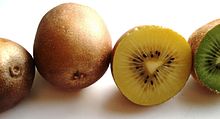Actinidia chinensis
| Actinidia chinensis | ||||||||||||
|---|---|---|---|---|---|---|---|---|---|---|---|---|

Kiwi ( Actinidia chinensis ) blossom |
||||||||||||
| Systematics | ||||||||||||
|
||||||||||||
| Scientific name | ||||||||||||
| Actinidia chinensis | ||||||||||||
| Planch. |
Actinidia chinensis is a woody lianas - Art . German names are Chinese ray pen or, after the edible fruits, kiwi . With these two names, however, other representatives of the genus of the ray pen are also referred to.
description

Actinidia chinensis grows as a large, left-winding vine. Young twigs are reddish in color with light-colored lenticels . They are covered with white hair or have rough bristles, older branches are usually smooth.
The stalked leaves are alternate on the branches. The petioles measure three to six, occasionally up to ten centimeters and are hairy like the young twigs. The leaf blade is broadly oval, broadly inverted ovate to rounded and broadest above the center. The tip of the leaf is blunt or ends in a short drawn tip. The leaf base is rounded to slightly heart-shaped. The underside of the leaves is light green and hairy, the upper side darker and smooth or hairy only on the leaf veins . Leaf veins end in the tips of the finely serrated leaf margin.
The yellowish or orange-colored flowers stand alone or in inflorescences of up to three flowers together. The five hairy sepals are broadly oval. The five petals measure one to two centimeters, are also oval and taper off at the base in a narrow foot. There are no hermaphrodite, but male and female flowers respectively. Plants. The Actinidia species are dioecious. The anthers are on five to ten millimeter long stamens . The numerous branches of the stylus spread apart (hence the name "ray stylus"). The organs of the opposite sex are always sterile. The upper ovary is hairy yellow.
The round berries are four to five centimeters in size. The initial hairs are quickly lost, when they are ripe they are smooth. The pulled back sepals as well as the style stick to the fruit.
This species is mostly diploid , but there are also some tetraploid populations.
The genome sequence has been available since 2013. The genome contains over 39,000 genes. The scientists examined the kiwi variety "Hongyang", which is widely grown in China.
distribution
Actinidia chinensis grows widespread in southeast China. To the north, the area is roughly bounded by the Yellow River . Altitudes of 200 to 600 meters are settled. The locations are forests, light secondary forests and bushland.

use
Actinidia chinensis is widely grown due to the edible fruits (the so-called kiwis) . The variety 'Hort16A' (brand name: Zespri Gold) with yellow flesh, selected in New Zealand , made this kiwi more popular and is offered alongside Actinidia deliciosa , which has been on the market for some time . It contains hardly actinidain , a protein -cleaving enzyme and therefore goes well with dairy products, unlike the grünfleischige kiwi, which makes bitter as yogurt, cottage cheese and desserts with raw fruits.
Systematics
Within the genus Actinidia , the species Actinidia chinensis is classified in the Maculatae section . Close relatives are the species Actinidia eriantha , Actinidia callosa , Actinidia guilinensis and Actinidia grandiflora . There is a special relationship to Actinidia deliciosa . This hexaploid species probably emerged from Actinidia chinensis through an increase in the number of chromosomes . When these two species are crossed, the germination rate is reduced, but there is also a genetic exchange between them in nature.
Individual evidence
- ↑ Huang et al. (2013): Draft genome of the kiwifruit Actinidia chinensis. In: Nature Communications, doi : 10.1038 / ncomms3640 .
- ↑ Pflanzenforschung.de: The queen of fruits Pflanzenforschung.de - The queen of fruits: Duplicated kiwi genome enabled the formation of valuable ingredients (November 8, 2013)
- ↑ Eating and drinking
- ↑ J. Chat, B. Jáuregui, RJ Petit, S. Nadot: Reticulate evolution in kiwifruit (Actinidia, Actinidiaceae) identified by comparing their maternal and paternal phylogenies. ( Memento of the original from September 22, 2007 in the Internet Archive ) Info: The archive link was inserted automatically and has not yet been checked. Please check the original and archive link according to the instructions and then remove this notice. in: American Journal of Botany. Ohio 91.2004,736-747. ISSN 0002-9122
literature
- J. Li, X. Li, DD Soejarto: Actinidiaceae. (PDF; 252 kB) In: ZY Wu, PH Raven (ed.): Flora of China. Vol. 12. Science Press, Bejging 2007. ISBN 1-930723-64-4
